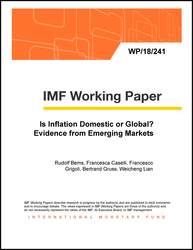
Is Inflation Domestic or Global? Evidence from Emerging Markets
Is Inflation Domestic or Global? Evidence from Emerging Markets
READ MORE...
Volume/Issue:
Volume 2018
Issue 241
Publication date: November 2018
ISBN: 9781484381595
$20.00
Add to Cart by clicking price of the language and format you'd like to purchase
Available Languages and Formats
| English |
Prices in red indicate formats that are not yet available but are forthcoming.
Topics covered in this book
This title contains information about the following subjects.
Click on a subject if you would like to see other titles with the same subjects.
Finance , Inflation , Economics- Macroeconomics , Money and Monetary Policy , WP , inflation expectation , inflation dynamics , Emerging markets , globalization , inflation , inflation expectations , Phillips Curve , price inflation , headline inflation dynamics , price pressure , Emerging and frontier financial markets , Inflation targeting , Output gap , Food prices , Global
Summary
Following a period of disinflation during the 1990s and early 2000s, inflation in emerging markets has remained remarkably low and stable. Was this related to a global disinflation environment triggered by China's integration into world trade and the broader globalization in these economies, or to better domestic policies? In this paper, we review the inflation performance in a sample of 19 large emerging markets in the past couple of decades and quantify the impact of domestic and global factors in determining inflation. We document that the level, volatility, and persistence of inflation declined significantly, albeit not uniformly. Our results suggest that longer-term inflation expectations, linked to domestic factors, were the main determinant of inflation. External factors played a considerably smaller role. The results are a useful piece of evidence as emerging markets craft their monetary policies to navigate the future shift in global financial conditions.
Copyright © 2010 - 2025
Powered by:
AIDC



